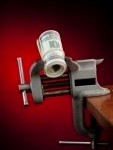WORLD INTERVENES AGAINST STRONG DOLLAR (1985–1987)
WORLD INTERVENES AGAINST STRONG DOLLAR (1985–1987)
 The excessive strength of the U.S. dollar proved detrimental to the world economy. The U.S. trade gap moved sharply into a deficit and millions of manufacturing jobs were lost. Sharp depreciations in the currencies of the
The excessive strength of the U.S. dollar proved detrimental to the world economy. The U.S. trade gap moved sharply into a deficit and millions of manufacturing jobs were lost. Sharp depreciations in the currencies of the
United States’ trading partners triggered surging inflation that required central banks to tighten aggressively, sending their economies into recessions.
After 10 ineffective attempts of currency intervention aimed at stabilizing the dollar between 1981 and early 1985, the world’s five biggest economies waged a global coordinated campaign to reverse the dollar’s ascent. The dollar had already peaked in February 1985 before starting a gradual retreat over the next six months. The decline was especially helped by Fed rate cuts in the second half of 1984 while rates remained unchanged in West Germany and Japan, and rising in the United Kingdom. [ad code = 3]
Despite the dollar’s 4 percent decline from its February peak to September, world leaders wanted more. In September 1985 at the Plaza Hotel in New York, representatives from the Group of Five (United States,
Japan, Germany, United Kingdom, and France) agreed on coordinated operations to support non-U.S. dollar currencies. A series of joint interventions totaling nearly $13 billion in dollar-selling operations by the G5 over the following five weeks helped bring down the dollar. The interventions worked: The dollar lost 20 percent from September to December 1985, before shedding another 27 percent in 1986.
Falling Dollar and Oil: A Boon for Non-USD Importers
The oil factor once again played a prominent role in currency markets. As the oil price drop of the mid-1980s intensified—resulting from slumping world demand and OPEC’s price declines—oil importing nations benefited significantly over time. The combination of a depreciating dollar and falling oil prices proved a boon for major oil importers, whose strengthening currencies increasingly absorbed cheaper oil, priced in a lower U.S. dollar. In
the early 1980s, West Germany and Japan were the two countries with the highest dependence on imported oil as measured in terms of their overall economy.
The chart shows Japan to have moved from being highly oilimport- dependent during the early 1980s—with an oil import/GNP ratio of 5.5 percent—to reducing its dependence fivefold over the following five years to become the most energy-efficient country in the industrialized world. An expanding Japanese economy and a strong yen were major contributors in reducing the relative value of oil imports. The decline in
West Germany’s oil dependence during the latter half of the decade was far more modest, mainly due to slowing economic growth.

